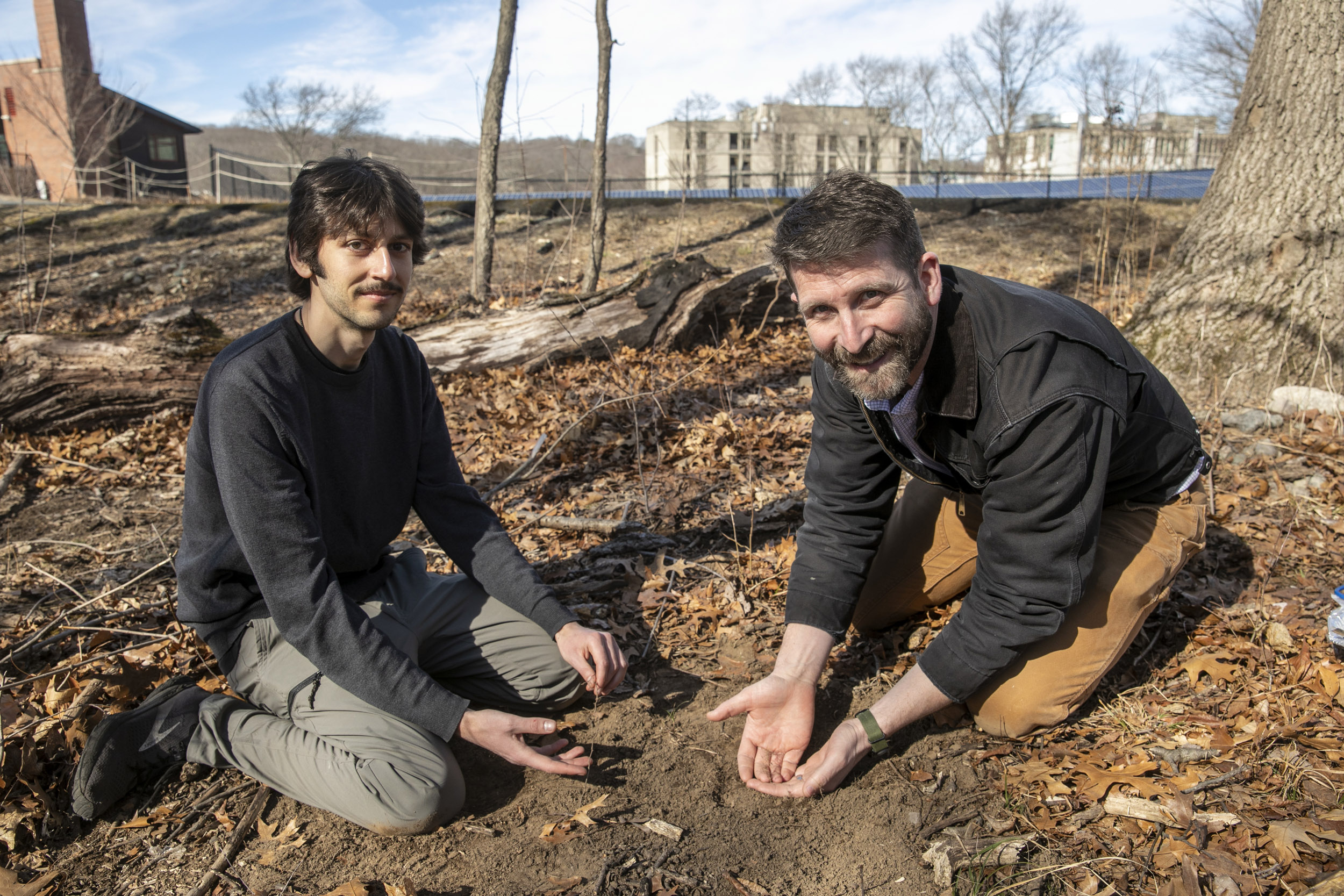Getting to root of possible carbon storage changes due to climate change

Ph.D. candidate Nikhil Chari (left) and Assistant Professor of Organismic and Evolutionary Biology Benton Taylor collect root exudates.
Jon Chase/Harvard Staff Photographer
Study looks at dynamics of how warming may affect capture in soil near trees, plants
The leaves of trees and plants have been called the Earth’s lungs because they take in carbon dioxide and give out oxygen. But beneath the soil’s surface, the roots of those plants are doing their bit for regulating the climate, facilitating the storage of carbon in the soil. But small changes in these processes can have considerable effects, as researchers in the Department of Organismic and Evolutionary Biology reveal in a study in Nature Geoscience.
Roots release exudates — organic carbon compounds — that interact with bacteria, fungi, and other soil elements to make its nutrients more accessible to the plant. “In its most basic sense, root exudates are materials that get put out into the soil to help the microbial community convert material that’s already in the soil into forms that the root can then take up and use,” explained Benton Taylor, assistant professor in OEB and the study’s senior author. “For example, root exudates can prime the soil microbial community to convert nitrogen to what’s called mineralized nitrogen, a form that’s usable for the plant.”
These exudates also interact with mineral-associated organic matter (or MAOM), where carbon gets bound to clays and other soil minerals, essentially capturing and storing it.
MAOM has been viewed as “essentially stable over decadal timescales,” according to Taylor, but the researchers found that changes in the rate and composition of root exudation can result in short-term changes to MAOM — and, thus ultimately, to the soil’s ability to store carbon.
“Root exudates are important regulators of soil carbon storage,” said Nikhil R. Chari, a Harvard Griffin Graduate School of Arts and Sciences student in OEB. Chari, the study’s lead author, points out that these exudates “are already small molecules so they can directly affect the kind of microscopic soil carbon that makes up MAOM.”
“If warming or other climate-change drivers change the types of exudates that are coming out on the plant, how is that going to affect these pools of carbon that would normally be in the soil for a long time?” Chari added.
To simulate different root exudates, the researchers fabricated three different exudate “cocktails” of simple sugars, amino acids, and organic acids and pumped them into soils using artificial roots. In a step distinguishing their experiment from prior work, the researchers performed these tests using intact soil cores from the Harvard Forest, rather than artificial or homogenized soil, preserving native soil biology, structure, and heterogeneity.
What they found showed the resilience of the soil — up to a point. “When we pumped just a little bit of exudate into the soil, the MAOM carbon pool did grow. It did accumulate bit by bit over time,” said Taylor. “When we pumped more exudates into the soil, more of those exudates made it into the MAOM pool — but the MAOM carbon pool didn’t get bigger. It just increased the rate at which MAOM was also being lost.”
“Our data suggests that this loss will also increase the release of carbon out of these long-term storage pools, and that we won’t necessarily see this long-term accumulation of stable soil carbon if exudation rates increase,” said Taylor.
This limitation has real-world implications. “If you think about plants having more carbon available to them as CO2 concentrations in the atmosphere rise, you might expect changes in their ability and their propensity to release carbon out of their roots,” said Taylor.
The researchers also found that their exudate cocktails had differing effects on the MAOM. The organic and amino acids resulted in a lower rate of MAOM formation — and, ultimately, a net carbon accumulation. However, the simple sugar exudates produced a greater MAOM turnover — the equivalent of giving soil microbes a “sugar high,” Taylor suggested.
“This gives us an idea of how these different exudate compounds will affect soil carbon dynamics,” said Chari. “What we really want to figure out is how these profiles, the rate of the carbon going into the soil and the types of carbon, like sugars or amino acids or organic acids coming in from the plant, are changing.”
The team, he said, is working with other researchers around the world on the effects of warming and elevated carbon dioxide to “be able to pair the actual changes coming out of the plant with how we see these different exudates affecting soil carbon dynamics,” said Chari. “This would allow us to better predict soil carbon dynamics in the future.”





